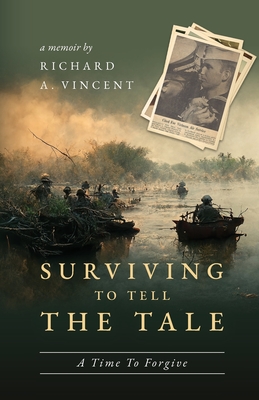You are here
Back to topSurviving to Tell the Tale: A Time To Forgive (Paperback)
Description
"An unflinching tale of overcoming childhood wounds and the aftermath of answering his country's call to duty. Richard Vincent shares his long road to self-forgiveness. This book is both evocative and transformative. Those who have traveled a like road will find hope in these pages." Susan Crandall, author The Myth of Perpetual Summer and Whistling Past the Graveyard
"...he's likely got a bestseller on his hands. Surviving to Tell the Tale-A Time to Forgive, is a look back at a life full of hopes and dreams that were met, dashed and rose again from the ashes. The book details an early start to a very successful career in photography, along with some fortunate alliances, and led to serving in the special forces with the U.S. Navy. "The squadron I was in, was classified top secret for over 35 years before I could tell anyone what I did." What he did was the stuff of legend. It's a fascinating read. One of his stories involves laying sensors around the perimeter of Khe Sahn. It was called the most vicious battle of the entire Vietnam war. Years later, Vincent's squad was given the Presidential Unit Citation, an honor reserved for extraordinary heroism in battle by a unit. "Somebody said thank you, finally." Vincent said quietly. Tim Timmons, Chief Executive Officer, Sagamore News Media
A pungent example of FDR's conception of war as "young men dying and old men talking" is provided by Richard Vincent's memoir, "Surviving to Tell the Tale: A Time to Forgive." Mr. Vincent describes a U.S. program of the Vietnam war so secret that its existence could not be revealed until early in the 21st century, when President George W. Bush pulled back the curtain.
The program centered on the U.S. need for better intelligence on increased activity of Viet Cong guerillas and North Vietnamese regulars who, with their supplies, clogged the Ho Chi Min Trail in Laos, enroute to a much greater mischief in nearby Vietnam. U.S. Defense Secretary Robert McNamara ordered an electronic "fence" to mark and surveil the trail. Never much one for small plans, Secretary McNamarra in this case pinned the project's fortunes to small planes: namely, P-2s, a type of aging and slow Navy submarine tracker that from low altitude would sprinkle the trail with fake twigs and other items of bogus foliage, embedded with movement sensors and tiny microphones for transmitting voices of unsuspecting VC and NVA troops.
If all this sounds a bit far-fetched for the late 1960s, Mr. Vincent points out that the Navy (through which as a teenager he found his way to Southeast Asia and volunteered for the secret program) had benefitted from years of experience using similar technology to surveil submarines - with one crucial difference. As Mr. Vincent explains in his memoir:
"The difference was, when over the ocean, the P-2's had nobody shooting at them. But {this new
type of} mission...would be over dry land, in enemy territory. So, every enemy soldier could take a pot
shot at one of these planes, which use a lot of hydraulics to work and were known to be highly
flammable, not to mention they had little armor protection. In addition, they would have to fly
incredibly low and slow to track exactly where the listening and moving detectors had fallen in the
jungle."
Mr. Vincent says he was unsurprised when Secretary McNamara looked past these pesky facts and gave the P-2 quick approval. "As far as McNamara was concerned," Mr. Vincent writes, "the planes and men were totally expendable, and throwing more soldiers into danger was a great strategy."
Young men and old men, indeed.
Mr. Vincent's memoir is full of historically significant insights like this, and he is an able navigator through the hellish fog of war. I found the book's combat descriptions downright riveting.
